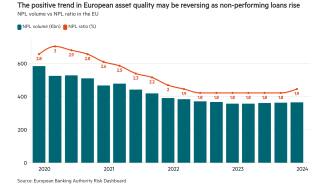As the EU’s fundamental review of the trading book (FRTB) 2025 implementation deadline nears, banks are adopting a conservative market risk stance under the Basel III framework.
Many lenders are opting for the standardised approach (SA) to calculate their capital requirements, avoiding the more complex and resource-intensive internal model approach (IMA), even if the SA leads to a higher capital charge.
Data from the European Banking Authority’s (EBA) second Basel III monitoring report, published in September, suggests the proportion of the largest Tier 1 banks using internal models will drop to 54% after FRTB implementation from the current figure of about 60% under existing reporting requirements.
For smaller Tier 2 banks, the transition is expected to be even larger: the EBA reckons 79% of these lenders will use SA after FRTB compared with 68% today.
According to Monsur Hussain, global head of research for financial institutions at Fitch Ratings, this shift can, in part, be attributed to the nature of some banks’ portfolios.
“Ultimately, for many banks, there’s actually not a business case for using internal models because the capital savings might naturally be limited by their particular portfolio profile,” he says.
Difficult to embrace
The complexity and infrastructure costs linked to IMA are also discouraging some lenders, according to Charlie Browne, head of market data, risk and quant solutions at data management solutions provider GoldenSource.
“There have been a number of reports of banks generally underestimating the infrastructure and processing costs of IMA. Based on our experience, I think that’s the case,” he says.
“If you’re a bank and you're assessing the capital gain generated through IMA versus the associated infrastructure costs, the investment doesn’t always add up.”
Mr Browne adds that for some smaller banks, in particular, updated FRTB risk measurement and reporting requirements make internal models difficult to embrace for now.
“The risk factor eligibility test, the profit and loss attribution test, and some of the Value at Risk back-testing rules that IMA require, they’re new. So, I think the smaller banks are waiting for the processes to bed in before they choose to go down the IMA route,” he says.
Beyond the quantitative elements of FRTB, banks will also be subject to qualitative guidelines that govern their “overall infrastructure and trading book processes”, according to Mr Browne.
These include a range of functions, such as independent price verifications, daily profit and loss, bid-ask and mark-to-market and prudential valuations, among others, that must meet regulatory requirements.
This need to bring trading book processes and infrastructure together is pushing banks to adopt cloud technology at scale. “FRTB and market risk regulation is forcing banks’ previously siloed infrastructures across front office, finance and risk to be centralised, and this is largely happening through cloud migration strategies,” says Mr Browne.
A delay in implementation?
Looking ahead, a capital hike looms for most European lenders with trading activity from January 2025. On average, FRTB will increase the total amount of capital banks will need to hold against their market risk by 35%, according to the EBA report. However, there is significant variability in how different banks will be affected at the individual level.
This comes as the EU’s implementation date, currently set for January 2025, sits comfortably ahead of its closest market peers, including the UK and the US, which are scheduled to go live in July 2025.
The start date discrepancy has led to some industry pushback against the EU’s first-mover status. Still, most experts say no clear market consensus has emerged, given the mix of advantages and setbacks inherent in any potential decision to delay FRTB implementation.
More on FRTB
“There will be some banks who have poured all their resources into trying to meet the January 2025 start date who might well want a delay, particularly if they’re running the internal model approach,” says Fitch’s Mr Hussain.
“Then other lenders are running a whole series of implementation programmes globally. They would probably prefer the existing start date because they’ve already planned, allocated resources and done their homework so that any change would disrupt their scheduling.”
Though EU authorities have the legislative flexibility to delay FRTB implementation, most observers expect the initial deadline to remain.












